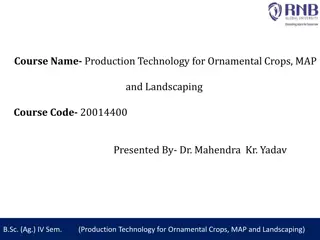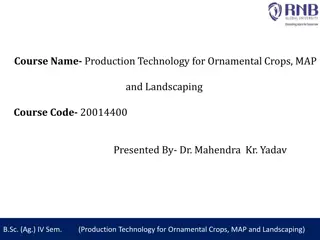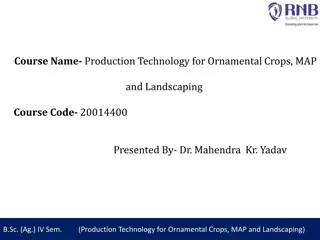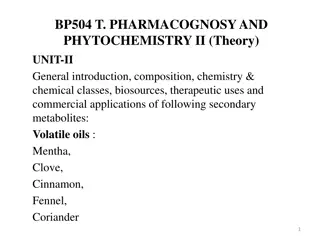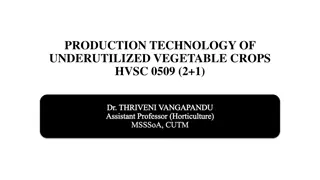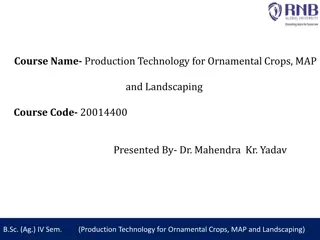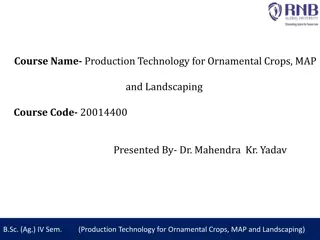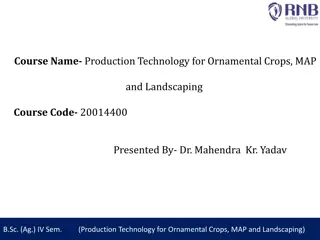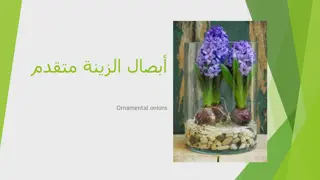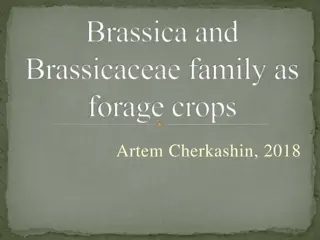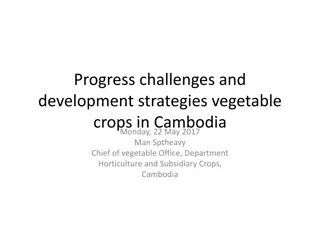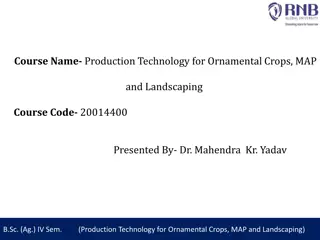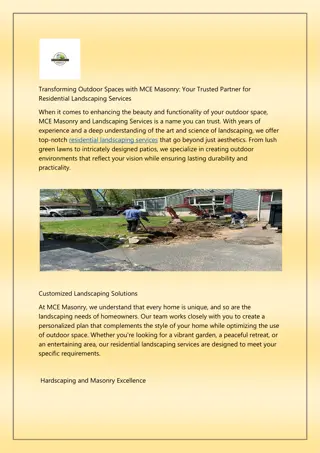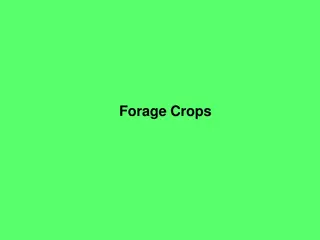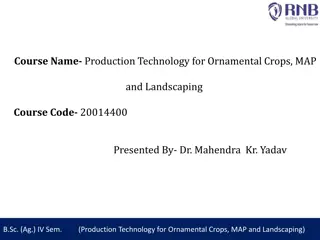Production Technology for Ornamental Crops, MAP, and Landscaping: Cinnamomum Production
This course covers various aspects of ornamental and medicinal crops, landscaping principles, and production technology. It explores the cultivation techniques of important ornamental crops, as well as issues related to medicinal and aromatic plants. Specifically focusing on Cinnamomum, the course delves into its botanical details, cultivation requirements, propagation methods, and improved varieties. Students will learn about the significance of processing and value addition in ornamental crops and MAPs production.
Download Presentation

Please find below an Image/Link to download the presentation.
The content on the website is provided AS IS for your information and personal use only. It may not be sold, licensed, or shared on other websites without obtaining consent from the author. Download presentation by click this link. If you encounter any issues during the download, it is possible that the publisher has removed the file from their server.
E N D
Presentation Transcript
Course Name- Production Technology for Ornamental Crops, MAP and Landscaping Course Code- 20014400 Presented By- Dr. Mahendra Kr. Yadav B.Sc. (Ag.) IV Sem. (Production Technology for Ornamental Crops, MAP and Landscaping)
Course Objectives Identify different types of ornamental and medicinal crops. Examine various principles of landscaping, uses of landscape trees, shrubs and climbers, production technology of important ornamental crops, etc. Determine about Demonstrate various Package of practices for loose flowers and their transportation, storage house and required condition for cut and loose flower. Construct about the various problems with the production technology of medicinal and aromatic plants. Importance of Processing and value addition in ornamental crops and MAPs produce. B.Sc. (Ag.) IV Sem. (Production Technology for Ornamental Crops, MAP and Landscaping)
Production technology of Cinnamomum B.Sc. (Ag.) IV Sem. (Production Technology for Ornamental Crops, MAP and Landscaping)
Production technology of Cinnamomum Botanical Name : Cinnamomum verum, Cinnamomum zeylanicum Family : Lauraceae, Chromosome No. :2n= 24 Origin : Sri Lanka and Malabar Coast of India Plant Part use Bark and Leaves Uses: Leaves of cinnamon also yield oil, main constituent of which is Eugenol. The oil possesses strong odour . B.Sc. (Ag.) IV Sem. (Production Technology for Ornamental Crops, MAP and Landscaping)
Soil: The quality of the bark is greatly influenced by soil, Well-drained, . Sandy loam soil rich in humus content is most suitable. Red dark brown soils free from rock, gravel are also good for cinnamon cultivation. Climate: Cinnamon requires hot and humid climate. Average temperature of 27 C are ideal. Propagation: Cinnamon is commonly propagated through seed, cuttings and air Layers. Cinnamon flowers in January and fruits ripen during June-August. The fully ripe fruits are either picked up from the tree or fallen ones are collected from the ground. Seeds are. removed from fruits, washed free of pulp and sown without much delay, as the seeds have a low viability. The seeds are sown in sand beds or polythene bags .The seeds germinate within 10-20 days. The seedlings require artificial shading till they become 6 months old. B.Sc. (Ag.) IV Sem. (Production Technology for Ornamental Crops, MAP and Landscaping)
Spacing: Planting: Pits of 50 cm are dug at a spacing of 3 x 3 m. They are filled with compost and-topsoil before planting. Cinnamon is planted during June-July to take advantage of monsoon for the establishment of seedlings. One-year old seedlings are planted. Partial shade in the initial years is advantageous for healthy and rapid growth of plants. Improved varieties: Navashree - It has high and stable regeneration capacity (6-7 shoots/year), high yield Nithyashree. Konkan Tej:.Released by BSKKV Dapoli in 1992. Variety has high volatile oil in bark (3.2%) Sweet Cinnamon and Honey Cinnamon B.Sc. (Ag.) IV Sem. (Production Technology for Ornamental Crops, MAP and Landscaping)
Manures and fertilizers st year: 20 g N, 18 g P205, and 25 g K20/seedling. Three years after planting: 30 kg F.Y.M., 4 kg neem cake, 150 g.N, 75 g P2O5 and 150 g K2Q per plant. The fertilizers are applied in two doses during first week of September and in March. Irrigation It can be successfully cultivated both under irrigated and rainfed conditions. Provision of irrigation immediately after planting and during summer season will ensure good yields. Interculture: In order to facilitate healthy soil atmosphere, soil works like spading, earthing up, etc. are required in aloe plantation. Weeding at regular intervals are some important intercultural operations. B.Sc. (Ag.) IV Sem. (Production Technology for Ornamental Crops, MAP and Landscaping)
Training and Pruning: When the seedlings become 2-3 years old, the shoot is cut back to a height of 30 cm from ground level to produce side shoots. This is called 'Coppicing'. Harvesting: Harvesting is done 2- 3 year after planting. Ideal time for harvesting shoots is from September to November. Side shoots having finger thickness and uniform brown colour are ideal for bark extraction. A testcut can be made on the stem with a sharp knife to judge the suitability of time of peeling. If the bark separates easily, the cutting can be commenced immediately. The stems of 2-3 cm diameter thickness and 1.0 1.25m length are cut close to the ground. Harvested shoots are bundled together and transported to the pack house for further post harvest procedures. Peeling is done with a small knife having a round edge at the end. Harvesting and Peeling should be done on same day. Cut stem earthen up with soil to encourage growth of new shoot. B.Sc. (Ag.) IV Sem. (Production Technology for Ornamental Crops, MAP and Landscaping)
Yield Yield: a. 3-4 year and onwards' - 62 to 125 kg quills/ha. b. 10-11 year and onwards - 225 to 300 kg quills/ha. 1 ton /ha leaves which yield 1 to 1.25 kg of oil are obtained per year. B.Sc. (Ag.) IV Sem. (Production Technology for Ornamental Crops, MAP and Landscaping)






